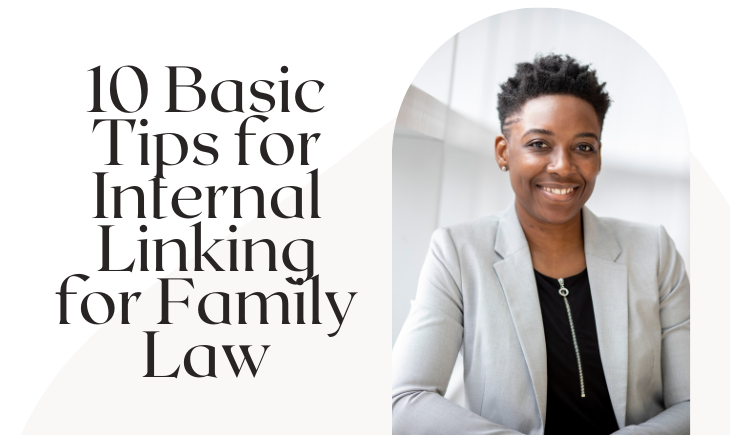Internal linking is essential to family law websites’ search engine optimization (SEO). It involves linking to other pages within your website, providing a clear pathway for users and search engines to navigate your content. Internal linking helps distribute link equity, improves website navigation, enhances user experience, and increases the visibility of important pages.
Here’s an essential guide to internal linking for law websites:
1. Create a Site Structure
Start by organizing your website’s content into a logical structure. Group related pages or content under relevant categories. This structure should reflect your law firm’s practice areas and the information hierarchy on your website. A well-structured website makes it easier for visitors to find information and search engines to understand the relationships between your pages.
2. Use Descriptive Anchor Text
Anchor text is the clickable text that’s within a hyperlink. When creating internal links, use descriptive anchor text that accurately reflects the linked webpage’s content. Avoid basic anchor text like “click here” or “read more.” Instead, use specific keywords or phrases that describe the linked page’s topic. Descriptive anchor text helps search engines understand the relevance of the linked page and improves user experience by providing clear expectations.
3. Link to Relevant and Related Content
When deciding where to place internal links, focus on linking to relevant and related content. Look for opportunities to naturally connect your pages by linking from one related topic to another. For example, if you have a page discussing personal injury law, you can link to another page that explicitly covers car accident cases. Linking to relevant content improves user navigation, encourages clients to explore more of your website, and signals to search engines that your website provides comprehensive information.
4. Prioritize Important Pages
Prioritize linking to your important pages, such as your homepage, practice area pages, attorney profiles, or contact page. You want these pages to rank well in search engine results and receive more visibility. By internally linking to these pages from other relevant pages, you help search engines understand their importance and increase their chances of being indexed and ranked higher.
5. Use Contextual and Natural Links
It’s important to create internal links that fit naturally within the context of your content. Avoid forcing or overstuffing links where they don’t add value. Instead, place links where they make sense and provide additional relevant information. Contextual and natural links improve user experience and signal to local search engines that your content is informative and user-friendly.
6. Utilize Menus and Navigation
Incorporate internal links within your website’s menus and navigation bars. This allows visitors to easily access different sections of your website and find the information they seek. Place essential pages and categories in prominent positions within the navigation menu. Including dropdown menus or submenus can further organize and structure your content, improving user experience and search engine crawlability.
7. Update and Audit Internal Links
Regularly review and update your webpage’s internal links to remain relevant and functional. Over time, content may change or be removed, resulting in broken or outdated links. Conduct periodic audits to identify and update broken links with the correct URLs. Broken links negatively impact client experience and can harm your website’s SEO.
8. Use Sitemaps
A sitemap is a file that provides a list of all the pages on your website, allowing local search engines to crawl and index your content more efficiently. Including an XML sitemap on your law website helps search engines comprehend the structure of your law website and discover all your important pages. Submitting your law website’s sitemap to search engines, such as Google Search Console, can facilitate the indexing process and improve the visibility of your content.
9. Monitor and Analyze
Monitor the performance of your internal links and their impact on user behavior and search engine rankings. Use awesome analytics tools, such as Google Analytics, to track your internal links’ click-through rates, bounce rates, and conversion rates. This data can provide insights into user engagement and help you refine your internal linking strategy to improve website performance.
10. External Linking Considerations
While internal linking is important, don’t overlook the value of external linking. External links to reputable and authoritative sources can add credibility to your content and improve its quality. Consider linking to external sources when they provide additional value or support to your content. However, ensure that external links open in a new tab or window to keep users on your law website.
Conclusion
In conclusion, internal linking is vital in optimizing your law website for search engines and improving user experience. Creating a well-structured website, using descriptive anchor text, linking to relevant family law SEO content, prioritizing essential pages, and monitoring your internal links can enhance website navigation, increase search engine visibility, and guide users to valuable information. Regularly update and audit your internal links to maintain their relevance and functionality.


